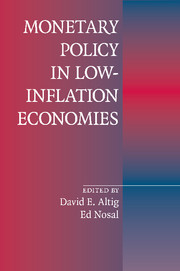Book contents
- Frontmatter
- Contents
- Contributors
- Acknowledgments
- Introduction
- 1 The Welfare Cost of Inflation in the Presence of Inside Money
- Commentary
- 2 An Open-Economy Model of Endogenous Price Flexibility
- Commentary
- 3 Efficient Inflation Targets for Distorted Dynamic Economies
- Commentary
- 4 Inflation and Welfare in Models with Trading Frictions
- Commentary
- 5 Good versus Bad Deflation: Lessons from the Gold Standard Era
- Commentary
- 6 Monetary Policy Orientation in Times of Low Inflation
- Commentary
- 7 Observations on Disinflation in Transition Economies
- Commentary
- 8 Inflation and Financial Market Performance: What Have We Learned in the Last Ten Years?
- Commentary
- Index
Commentary
Published online by Cambridge University Press: 26 January 2010
- Frontmatter
- Contents
- Contributors
- Acknowledgments
- Introduction
- 1 The Welfare Cost of Inflation in the Presence of Inside Money
- Commentary
- 2 An Open-Economy Model of Endogenous Price Flexibility
- Commentary
- 3 Efficient Inflation Targets for Distorted Dynamic Economies
- Commentary
- 4 Inflation and Welfare in Models with Trading Frictions
- Commentary
- 5 Good versus Bad Deflation: Lessons from the Gold Standard Era
- Commentary
- 6 Monetary Policy Orientation in Times of Low Inflation
- Commentary
- 7 Observations on Disinflation in Transition Economies
- Commentary
- 8 Inflation and Financial Market Performance: What Have We Learned in the Last Ten Years?
- Commentary
- Index
Summary
It is well known that a variable that is the subject of control—in this case, inflation—loses its ability to be predicted by the variable being manipulated to effect that control—either the output gap or fluctuations in money around its trend, depending on your preferred model. In other words, the correlation between the two variables is destroyed by the process of control.
The reason for this is straightforward. Without control, a shock that causes the output gap or money to move will result in a subsequent move in inflation. With control, a shock that would otherwise cause the output gap or money to move will either be offset by a preceding monetary policy action, leaving both inflation and the output gap or money unchanged, or result in a policy-induced offsetting move in the output gap or money, leaving inflation alone unchanged. In either case, inflation will be uncorrelated with money or the output gap because it remains largely unaffected.
There are two caveats to this loss of correlation. First, imperfect offsets by monetary policy to shocks will show up in the output gap, money, and inflation. If such policy errors are frequent, the correlation will be reduced but not destroyed. Second, a change in the trend growth rate of money will still be reflected in the trend inflation rate.
- Type
- Chapter
- Information
- Monetary Policy in Low-Inflation Economies , pp. 207 - 214Publisher: Cambridge University PressPrint publication year: 2009



